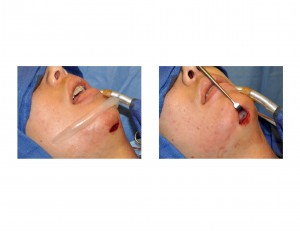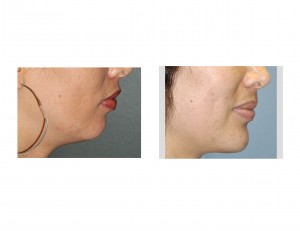Background: An underdeveloped jaw or mandible has been historically treated by chin and jaw angle implants. A chin implant enhances the front part of the jaw while jaw angle implants augment the posterior part of the jaw. While these types of facial implants are tremendously effective at augmenting the two obvious prominences of the jaw, they neglect the intervening part of the jawline between the two of them known as the body area.

Case Study: This 33 year-old female was having a skull reshaping procedure and wanted to improve her mildly weak chin as well. She felt her overall jawline was weak and not just her chin area but she did not want her jaw angles to be any bigger or flared. Her horizontal chin deficiency measured only 3 to 4mms in projection.
A new uniquely designed jaw implant was selected for her known as a jawline implant. It is essentially a very long and thin extended chin implant that extended back to the jaw angle area creating a wrap around effect along the inferior border. While the chin projection of the implant was 4mms, it tapered back along the jawline to a 2mm feathered edge. Because of its thin and long design, the stiffness (durometer) of the silicone material was stiffer than that used in other facial implants. That extra stiffness prevents the back tail of the implant from folding onto itself on insertion.


Case Highlights:
1) A more defined and distinct jawline is a desireable feature for both men and women and is the result of a more defined inferior border of the mandible.
2) A jawline implant is different than other jaw implants such as a chin or jaw angle implants as it accentuates the mandibular inferior border from the chin back to the jaw angles.
3) Jawline implants can be used alone to enhance a mildly weak jawline or as an additive benefit to facelift surgery.
Dr. Barry Eppley
Indianapolis, Indiana


